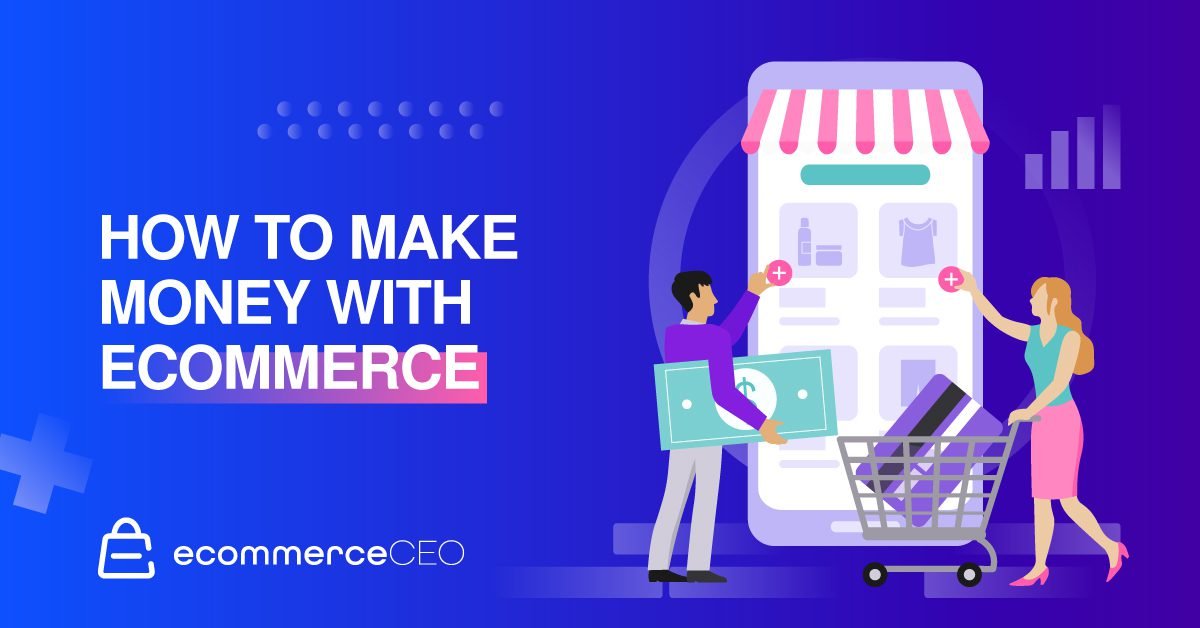Starting an ecommerce business in today’s economy is easier than you might think, but to be successful, you need to do a bit of homework first.

If you want to know how to make money with ecommerce, you must first understand the various business models you can choose from, how it makes money, and the steps you must take to start your business.
Ecommerce is short for electronic commerce. It’s the process of buying and selling goods or services online. The eCommerce business world sales are projected to reach $7.4 trillion by 2025.
Ways To Make Money With Ecommerce
There are a few business models you can choose from when it comes to making money online.
Dropshipping
Dropshipping involves listing products on your own website from other suppliers. When a customer makes a purchase, the order is sent directly to the supplier for fulfillment.

You never have to hold inventory and keep the difference between what the supplier charges and what the consumer pays as profit.
Print on Demand
Print on demand (POD) involves working with a third-party supplier to customize white label products (clothing, home decor, kitchen and bath items, etc.) with your own designs.

It works like dropshipping – you don’t pay anything until a customer places an order. Unlike dropshipping, products are made to order rather than stocked and ready to go the moment someone makes a purchase.
Amazon FBA
Amazon FBA is a program where Amazon handles fulfillment for you. You find the product you want to sell, purchase it, send the inventory to Amazon, and let them handle shipping the orders to customers while you take care of the marketing efforts.
Retail Arbitrage

Retail arbitrage is one of the simplest business models. You purchase items on sale or clearance at big box stores, then list them for sale on online marketplaces at a higher price.
Affiliate Marketing
Affiliate marketing involves selling someone else’s products or services and earning a commission on each sale. It’s also a good way for you to increase your revenue without paying a sales team if you have a product you want to sell online more of. By having people join as affiliates, they market your offering for you, and you pay a portion of the sale to them for their effort.

As an affiliate marketer, you can build an ecommerce website around a particular niche, then join multiple affiliate programs to promote products and services to your readers.
Private Labeling
Let’s say you have an idea for a product but don’t have the capital to find or build a factory to make it for you. Private labeling may be the answer.

You can hire a company to create a product to your specifications and ship the inventory directly to you for selling – or to a third party like Amazon to handle fulfillment for you.
White Labeling

While labeling is like private labeling, except you don’t get a product built directly to your specifications. You use the same product another company is already selling but put a custom label and packaging with it. It’s most commonly found in the health and beauty industry.
How Ecommerce Makes Money
No matter what business model you pick, ecommerce makes money the same way – driving traffic to your website and getting people to buy what you offer. Niche products, whether physical products or digital ones tend to do better.

A customer visits your website via their web browser and places an order. The SSL certificate passes information securely from the customer to your payment gateway to collect the funds. The funds transfer to your merchant account and then to your business bank account, while the order moves to fulfillment. The customer receives a transaction confirmation email, and once fulfillment is complete, the customer gets an email with tracking information.
Starting an Ecommerce Business
To start an ecommerce business and make money online, follow these basic steps for a strong ecommerce strategy.
Choose a Product to Sell
You can’t have an ecommerce business without a product to sell. With so many options, it can be hard to know which ones to choose. That’s where product research comes in. It can help you decide if you’ll make and sell things of your own or purchase inventory to sell.
Find Your Audience
No matter what product you sell, the right audience is crucial. If you’re marketing to the wrong people, you’ll struggle to make sales. What problem does your product solve? Find the people who are dealing with that problem. Think about the customer journeys for each segment of your audience and create an inbound marketing campaign for each of them.
Choose Your Ecommerce Platform
With your product, business model, and audience in mind, it’s time to build your website. You’ll need an ecommerce platform to support you. If you’re dropshipping, you’ll need to use a platform that integrates with your supplier to make business operations easier.
Start Digital Marketing
When everything is ready to go, start marketing campaigns to support your business. Use a combination of email marketing campaigns with relevant email follow-ups, social media marketing, and content marketing to help you get started.
The good news is that there are various free tools you can use to help you get started.
How to Grow A Profitable Ecommerce Business
A profitable ecommerce business is all about cash flow and profit margins. You need to earn enough income to pay your expenses, and what’s left is your cash on hand. If your business has money tied up in assets like inventory, you can’t invest it in other value-added activities like marketing. It can take some time for your business to grow so that you remain cash flow positive, but the key is to consistently reinvest profits to foster growth. As you do, you’ll get a greater return on investment.
Invest in the Right Ecommerce Platform
Everything starts with the right ecommerce platform. Some platforms are better suited to certain business models than others. Shopify, for instance, is considered the best for dropshipping.
If you’re not highly technical and don’t have the budget to hire professional designers and developers, then using a self-hosted platform like WooCommerce isn’t the best option for you. That’s where hosted platforms like Shopify, BigCommerce, and Wix make things easier.
Drive Traffic with Blog Posts
A blog is a wonderful way to reach prospective customers. Creating content around keywords your target audience may be searching for will make it easier to generate website traffic. Search engine optimization (SEO) is an important part of your inbound marketing strategy, so ensure each blog post is written with SEO in mind. Over time, as it ranks, it will bring in organic traffic, which will help you earn more money.
Expand to Multiple Sales Channels
While your own online store is a great place to sell products when you’re starting your online business, using additional sales channels will bring in more revenue faster.
Most ecommerce businesses generate sales through multiple channels of distribution such as social media and online marketplaces like Amazon, eBay, and Walmart.
Build an Email List
Connecting with your audience on social media platforms is great, but you don’t own those websites. If Facebook shuts down tomorrow, you’ve lost all those connections. Email marketing allows you to connect directly with your prospects and customers. You can use automation to make it run on its own while you take care of other aspects of your ecommerce store. Check out these eCommerce business examples and see how successful brands grew their revenues with the right email marketing automation in place.
Offer an incentive for website visitors to provide their email address to you – such as a discount code on their first order. If you’re selling digital products or services, you could try offering an ebook, whitepaper, or other downloadable assets to further educate your customers about your brand and offerings.
Use Shopping Ads from the Beginning
Shopping ads are an important part of search marketing that can go a long way toward generating traffic. Your ecommerce store can start making money fast with Google Shopping ads.
Run Facebook Ads
A strong social media presence is an important part of a successful ecommerce business. To build brand awareness and grow your following, use Facebook Ads. Not only can you use them to increase your follower count, but you can drive more traffic to your ecommerce store or sell products directly on Facebook. Paid ads are a great way to get sales rolling when you’re still building brand awareness.
You can also run paid ads on Google for a search marketing campaign.
Make Retargeting Part of Your Strategy
Retargeting allows you to advertise to people who have visited your online store on other websites they see online. You can customize retargeting campaigns to people who’ve visited particular pages, those who abandoned carts, and more.
Use Dynamic Retargeting
Dynamic retargeting is a type of retargeting that creates unique ads for each of your online shoppers. It uses machine learning to analyze individual behaviors to customize offerings to encourage a purchase.
FAQs
Final Thoughts
As a business owner, you’ll need to spend time researching other successful ecommerce companies in your niche to help you decide how you’ll differentiate yourself from the competition.
You can start your own ecommerce company with a limited budget, thanks to dropshipping and print-on-demand. You can also create your products like online courses. No matter your path, it’s possible to earn a profit.









